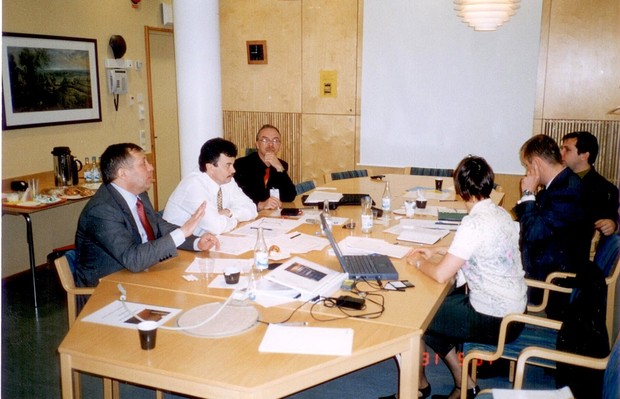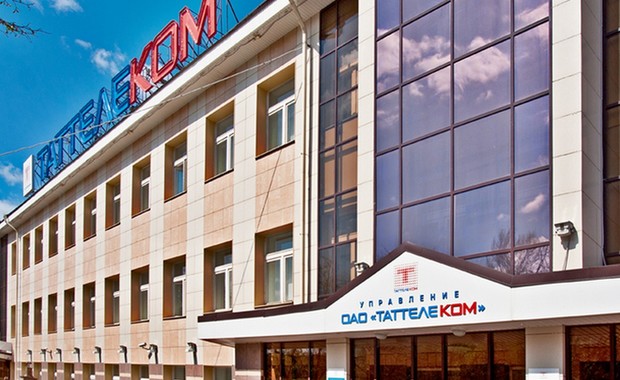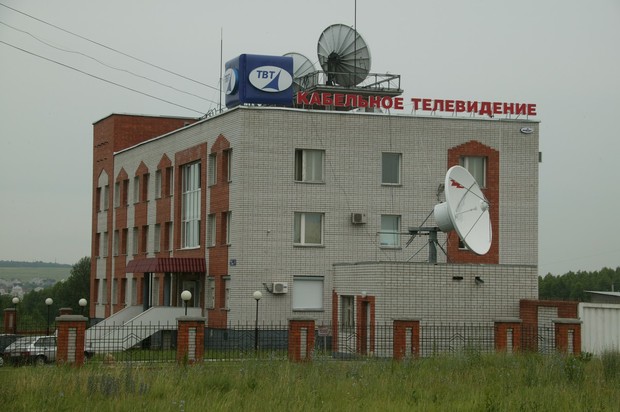About how new communications services spread in Tatarstan
With the introduction of the first GSM-operator TAIF layed the foundation for other telecommunication projects
Today, when wireless Internet access has already become commonplace, we do not feel how and when there was a real technological breakthrough — in spite of the considerable difficulties in Tatarstan the problem of installation of telephones has been resolved, broadband Internet and cable TV have been introduced. The team of TAIF took a leading role in this process. The newspaper Realnoe Vremya already wrote about the difficulties of TAIF when expanding its regional network under the trademark Santel, about how they opposed to the federals, winning back infrastructure created by their own. About the further development of the telecommunications business, the involvement of TAIF in the communications reform in Tatarstan and what a positive impetus was given to the Republic due to this – in the report of Realnoe Vremya.
To accelerate
Against the background of the constant increase of market requirements, TAIF was rapidly developing telecommunications business. When they were building the infrastructure for the first in Tatarstan cellular operator of GSM standard Santel they layed a high potential power for many years of service. The corporate spirit of TAIF – to focus only on the best technological advances — made possible after the establishment of the company TAIF-Telkom, a mobile operator, to establish in the autumn of 1999 the company TVT for the introduction in Tatarstan of broadband communications services and, first of all, cable television.
'TAIF was a pioneer here,' noted Director General of MGS Aleksander Leontyev to Realnoe Vremya. 'Its subsidiary, the company TVT was first who introduced the cable television and broadband Internet in the Republic. It was a great novelty.'

The emergence of a new direction of business was not only due to manufacturing requirements. Of course, the expanding holding required digital data transmission system – for the interests of the group it was necessary to provide reliable communication channels between cities. Besides, the Director General of the company had a dream – to create multi-channel cable television in Tatarstan. The idea came up suddenly. Then Albert Shigabutdinov often had to go on business trips, including abroad. In the hotels where he stayed a rich variety of TV channels with a huge number of scientific and educational programs always attracted his attention. It was a novelty: a television – but about science, technology, nature. In that time he had the dream and then the goal — to create a new direction of communications business, Tatarstan cable television with a minimum of 200 channels. 'I wanted to awaken the inquisitive mind, a thirst for knowledge,' recalls Albert Shigabutdinov. 'We could not influence the educational system, the educational programmes in the institutions. But I knew that if Tatarstan youth received such educational television, it would awaken their curiosity, make them more interested in science and the world.' Albert Shigabutdinov recalled how in his childhood his family was one of the first who got a TV. 'There was no variety of channels, and the broadcast was not 24 hours a day, like now, but only from 18-19 p.m. Neighbors stood in line to watch favorite shows. And I saw how television changed the culture of communication between people, how it made them interested in something new,' says the head of TAIF.
Technological breakthrough
With the emerge of the company TVT there was a new revolution in the telecommunications business of TAIF – the implementation of broadband communication services and, first of all, cable television. Having studied foreign experience, in the summer of 2001 the company TVT started the construction of a transport telecommunication network throughout the country, connecting all towns, large settlements and rayon centers of Tatarstan with fiber-optic communication lines. In total, the largest Russian multiservice network with a capacity of 180 thousand apartments was built and put into operation for a year. In the first year of operation more than 50 thousand apartments and organizations of the city were connected to the network.
In June 2003, the telecommunications network TVT which covers three cities of the Republic was commissioned. And due to the second phase there was the connection of all other regional centers.

Obstacles to further progress
At the same time, the management of TAIF intended to continue the ongoing development of communications across the Republic. After the sale of the first in Tatarstan the regional cellular network Santel, TAIF still had two stations of urban connection, the complete modernization of which was carried out for the smooth accession of the mobile communication to the telephone network of general use.
Out-of-date telephone exchanges in Tatarstan did not meet the requirements of modern times. They prevented to step beyond the traditional telephone service. The whole industry required reforms. But the reform was stopped by an old way of thinking, rooted in the mechanism of distribution of communication during Soviet times, when it was officials, whether the Minister of Communications or the chief of rayon telephone exchange, who decided where and who needed a telephone. 'Communication was a real shortage,' recalls Albert Shibutdinov. 'And people who distributed it had additional power. In any region the Minister of Communications was the first person after the party leadership, he often personally decided whether to give someone a phone or not. And only after them the most influential were the chiefs responsible for food trade, industrial trade and so forth.' The access was very limited, it was possible to expand it by installing of digital equipment and fiber optics that could transmit much more information at significantly higher speed.
New investments for further development
Later there was another stumbling block. In most Russian regions one and the same company provided services of local and long-distance communications. In Kazan the situation was different: Kazanskaya GTS was engaged in city communications, and Tattelekom— a long-distance and international. The interaction between the two communication companies was organized on a contractual basis. It was inconvenient for the users of communication services: to get one service, they had to sign separate contracts with each enterprise.
This separation complicated the situation even more. Besides, the company could not at that moment to reform networks to adapt them to the new, emerging services. This difficult situation in the industry attracted the attention of the President of the Republic Mintimer Shaimiev and Prime Minister Rustam Minnikhanov, who proposed to reform the industry. State-owned companies could not do it on their own, and as time went bythe strategy of 'dog in the manger' would lead to the collapse of the telecommunications industry. In 2005 in order to resolve this situation, and in fact – to reform communications, they involved TAIF, which accumulated a vast experience in the development of the telecommunication sector of Tatarstan by that time.

'We agreed with the leadership of the Republic that our team of five-six people for two or three years would join the Board of Directors of Tattelekom, would conduct the necessary reforms and go out of business,' says Albert Shigabutdinov.
The first necessary step was the merger between Kazan GTS and JSC Tattelecom, or better say, the acceleration of this process. The problem emerged even earlier, and about the merger of two largest communication operators they started thinking in 2000 when similar processes were active in Russia. And TAIF was an active supporter of the integration of two companies. The merger, in the first place, was necessary in order to attract new investments for further development.
'At that time, everyone actively rushed to the stock exchange, through which it was possible to involve cheaper money than bank loans. But if Kazanskaya GTS by the beginning of 2000s was already a joint-stock company, and in their case the programme of American depositary notes was started, Tattelekom was a state-owned enterprise. And its transformation into a joint-stock company ended only in 2003. During next 2 years they were considering and thinking over different variants of merger,' says the Director General of investment company Elemte Zakiya Shafikova who participated in this process.
About the possibility of the merger they started to talk openly in the winter of 2004. By this time, the Board of Directors of Tattelekom had approved the scheme of merger, under which ordinary and preferred shares of the Kazanskaya GTS would be converted into additional ordinary shares of Tattelecom. The merger was completed in the spring of 2006.
Kazanskaya GTS became a part of JSC Tattelekom as a branch. The merger company kept the name Tattelekom and acquired the entire effective pool of existing telecommunications assets that were necessary for the development of infrastructure of the industry. The merger process was not easy. The merger dragged on due to the fact that the Kazanskaya GTS was owned by private persons, that time its stock could be bought in the stock market. The shareholders were natural persons as well, and the company Elemte; by the way, 5% was owned by TAIF.
Albert Shigabutdinov, in his holding company of whom a special team to work with Tattelekom was created, was chosen as the chairperson of the Board of Directors of Tattelekom.
Under the leadership of TAIF management the five-year strategic development plan of Tattelecom was developed. And despite the fact that the merger of two largest telecommunications operators increased capitalization of the company, TAIF required drastic measures to increase the fixed capital of the new merged company. TAIF was a guarantor of Tattelekom lending. Also, due to attracted investments new technologies were introduced: modern digital telephone exchange replaced the outdated stations, and a triple reservation was established for trouble-free operation.
Digitalization of the entire network Tattelekom
During the period of joint work, the software modification of automatic long-distance telephone stations (AMTS) in Kazan and Naberezhnye Chelny was carried out. It allowed the subscribers to choose a network operator of long-distance and international communication. In the autumn of 2006, in order to provide the traffic accounting at the connection points the work was carried out on the extension of telephone stations in Naberezhnye Chelny. The capacity of automatic long-distance stations increased by 1339 channels and amounted to 14 599 channels. The same was done in Kazan. Besides, Tattelekom fully transferred its subscribers to the new procedure of dial of operators of long-distance communication. Earlier, the telephone network in Kazan was converted into 7-digit numbering. The transference was made simultaneously by mobile operators at all telephone exchanges of the city, and the transition to the new numbering was carried out without suspension of stations work. Due to the transition to 7-digit numbering, the capacity of the network increased and over 2 million numbers could be given in the operation.

By 2007, Tattelekom was the first in Russia who completed the implementation of the national priority project 'Obrazovanie' ('Education'), having connected 2 245 educational institutions of Tatarstan to broadband Internet access. The digitalization of rural telephone networks of the Republic of Tatarstan was completed. Subscribers in remote settlements finally had access to modern communication services. A year later, in 2008, Tattelekom was the first in Russia who completed the process of digitization of all its own network, having replaced analog telephone exchange equipment to the equipment of NGN level. And this was the next generation of networks resulting from merging of the Internet and telephone networks. NGN is a universal multipurpose network that supports all types of services ranging from basic telephony to the transfer of data, images, multimedia, broadband applications. This technological breakthrough allowed us to take a step beyond the traditional telephony.
'What Tattelekom offers today, the main operator in Tatarstan, does not offer any other Republic,' believes Director General of MFS Aleksander Leontyev. And the confirmation of this — the words of the Director General of Tattelecom Lutfulla Shafigullina: 'Today we have wide prospects, a strong economic foundation has been created, a favorable investment climate, modern infrastructure. Certainly, a great contribution to the strategic development of the company, anticipating the needs of business and society, was made by far-sighted management of the company and its Board of Directors under the leadership of Albert Shigabutdinov.'
Having decided that TAIF goals had been fully fulfilled, in the spring of 2009, the group resigned from the Board of Directors of the operator. At the annual meeting of shareholders of Tattelekom it became known that Director General of TAIF JSCAlbert Shigabutdinov, the head of the Board since 2005, was replaced by Valery Sorokin, Director General of the state JSC Svyazinvestneftekhim. Commenting on the event, Albert Shigabutdinov said that one of the best telecommunication companies in the result of the merger with the Kazanskaya GTS the authorized capital of Tattelekom increased from 1.6 to 2.08 billion rubles. Multisectoral holding decided to focus on its other assets, among which was TVT.

Trump card of telecommunications industry of Tatarstan
TAIF has achieved its ambitious goals in this area. TVT became the largest TV provider in Tatarstan. It has almost 700 thousand subscribers of cable TV in 15 towns, and digital television in 10 cities. If to talk about Kazan, the share of TVT in the cable TV market was 55% at the end of 2010, in Naberezhnye Chelny – 72%. The company also provided broadband access services to the Internet in eight cities and fixed-line telephony in Kazan, Nizhnekamsk and Naberezhnye Chelny. Coverage of broadband access to the Internet amounted to about 600 thousand houses in the Republic. The company also provided the fixed telephony services in Kazan and served 13% of the total number of fixed-line subscribers in the city with installed capacity of 110 thousand numbers.
TAIF brought to a logical conclusion the development of the telecommunications business of the holding company. In the autumn of 2011, a deal between TAIF and MTS for the sale of Tatarstan largest cable operator TVT at $180 million was arranged.
Without exaggeration, the company TVT was the trump card of the telecommunications industry in Tatarstan. The network TVT allowed to create not just e-town but to provide most part of the population with various services, having created, in essence, an electronic Tatarstan, inside of which now all the information resources of Tatarstan is concentrated, and it is no less than the whole electronic documents circulation system of public administration implemented through the project 'Electronic government'. The penetration of services of broadband access to the Internet has allowed more people to pay fees, fines, control tax debts and much more in the self-service mode via infomats 'Electronic Tatarstan'. New standards were also set by created 'United payment center' – its online services and terminals allowed to pay utility bills, bills for cable TV and mobile communication, to pay for kindergarten. Besides, high-speed Internet gave the opportunity Tatarstan banks to offer online services, and people could repay the loans without leaving their house. Entrepreneurs also have the opportunity to manage their businesses remotely, to conduct e-auctions. All of this allows Tatarstan to integrate into the world system of business relationships. About a detailed review of these information resources, the path to development which paved a progressive telecommunications projects of TAIF you can read in our next article.
Photo: press centre of TAIF JSC
Part 2. Shaimiev's first mobile call or how Santel gathered 300,000 users within two years